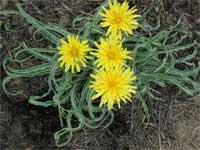- Forest Service Home
- Celebrating Wildflowers
- Home
- About Us
- News & Events
- Wildflower Viewing Areas
- Wildflower Ethics
- Forest Service Regions
- Just For Kids
- Teacher Resources
- Pollinators
- Native Gardening
- Native Plant Materials
- Invasive Plants
- Rare Plants
- Beauty of It All
- Interesting Plants
- Unique Communities
- Ethnobotany
- Special Features
- Wildflower Links
- Contact Us
USDA Forest Service Celebrating Wildflowers
|
|
|
Rocky Mountain Region Viewing AreaLOCATION and PHOTOS
Toadstool Geologic ParkForest: Oglala National Grassland District: Pine Ridge Ranger District Description: This area is mostly characterized by native mixed-grass prairie with wooded streambeds and “badlands” – steep, eroded, sparsely vegetated formations created by water and wind erosion on layers of siltstone, sandstone, and clay. Toadstool Geologic Park is such an area, and is named for narrow clay pedestals topped with slabs of sandstone that look like huge toadstools, although many of the large ones have fallen. Viewing Information: Stop at the district office in Chadron to pick up a map of the grassland, get directions, and learn about any hazards or seasonal wildflower viewing opportunities. Many wildflowers await the visitor to this unique geological feature. Species encountered in the spring are Missouri milk vetch (Astragalus missouriensis), shell-leaf penstemon (Penstemon grandiflorus), gumbo lily (Oenothera caespitosa), and death camas (Zigadenus spp.). As spring moves into the summertime yellow evening primrose (Oenothera serrulata), ten petal blazing star (Mentzelia decapetala), slimflower scurfpea (Psoralidium tenuiflorum), and spiderwort (Tradescantia bracteata) dot the landscape. As autumn brings a close to the flowering year goldenrods (Solidago spp.), and broom snakeweed (Gutierrezia sarothrae) are commonly seen across the landscape. In addition to native prairie, the Oglala Grassland is the best place in Nebraska to view pronghorns. There is a small campground (no water available) at Toadstool Geologic Park that makes a good launching point to explore the area. A $3 per vehicle day use fee is charged from Memorial Day through Labor Day. A one-mile loop trail from the picnic area highlights many examples of eroded clay/sandstone formations. Pick up an interpretive brochure at the trailhead to learn about the area's fascinating geology and paleontology. A reconstructed sod house provides a look into the past when homesteaders on the prairies used the only abundant building material available. The 3-mile Bison Trail goes from here to the Hudson-Meng Research and Education Center, which is a site consisting of a 10,000-year-old Bison antiquus bonebed. Safety First: Roads in the Oglala National Grassland vary from paved state highways to four-wheel drive only. Most of the roads are gravel and are passable except after a rain or a snowstorm. Trains run as frequently as every 7.5 minutes over the track you cross as you turn off of Toadstool Road. Be sure you look both ways before crossing the tracks! Directions: Go 4 miles north from Crawford, Nebraska, on Nebraska highways 2 and 71. Turn northwest on Toadstool Road, and go about 10 miles. Turn left at the sign to Toadstool Park and go about 1½ miles. Ownership and Management: U.S. Forest Service, Oglala National Grassland, Pine Ridge Ranger District (308) 432-0300. Closest Town: Crawford, Nebraska. For More Information: |
|
| NOTE: PDF format links require the Adobe Acrobat Reader to view. | |
| top | Disclaimers | FOIA | Privacy Policy | Quality of Information | Photo Credits & Use |
Location: http://www.fs.fed.us/wildflowers/regions/rockymountain/ToadstoolGeoPark/index.shtml
Last modified: Thursday, 10-May-2012 15:02:49 EDT



